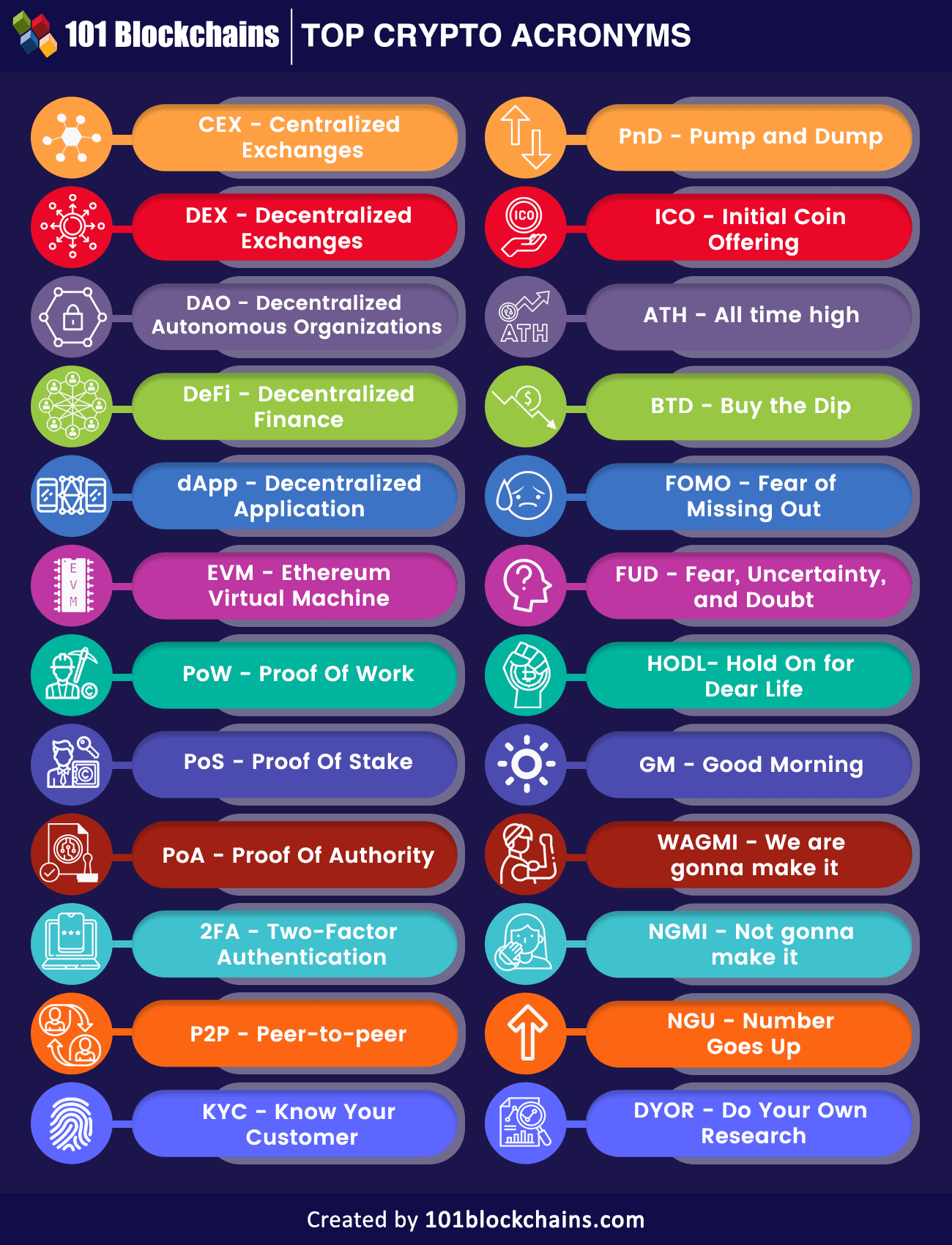Unlock your crypto career potential — become a Certified Cryptocurrency Professional (CCP)™ and master the skills that set you apart in the fast-evolving world of digital assets.

- Cryptocurrency
James Howell
- on January 18, 2023
Top Crypto Acronyms That You Should Know
The terms ‘cryptocurrency’ and ‘blockchain’ might have become common for tech professionals. However, the average person interested in cryptocurrencies is most likely to encounter confusion in understanding different concepts within the crypto domain. The list of new crypto acronyms and terms can be quite confusing, especially when you are a beginner. Therefore, you need to understand the meaning behind different abbreviations to avoid the problems of crypto jargon. Cryptocurrency has evolved as a promising alternative to traditional financial instruments like bonds and stocks. Most of the young, tech-savvy investors opt for trading in cryptocurrencies across multiple platforms.
In addition, the need to learn A to Z of cryptocurrency has escalated by huge margins in recent times. Interested investors could access different platforms for sharing information about cryptocurrencies and relevant trading strategies. On the other hand, the problem of understanding crypto jargon continues to affect the decisions of many crypto beginners. The following discussion will outline the important abbreviations in the domain of crypto.
Learn in-depth on cryptocurrency and how blockchain technology empowers cryptocurrencies by Enrolling in Cryptocurrency Fundamentals course.
Common Abbreviations in Crypto
The popularity of cryptocurrencies has sparked widespread interest in crypto terminology lists alongside drawing more users to the crypto landscape. At the same time, the consistent evolution of new and innovative terms in the domain of cryptocurrencies presents formidable challenges for beginners. No one is an expert blockchain or crypto professional when they enter the field and could have different perceptions of crypto terminology. As a matter of fact, beginners experience difficulties in understanding common crypto phases, which can affect their decisions. However, you don’t have to worry about such problems when you can access a detailed list of crypto abbreviations. Let us take a look at the common technical abbreviations alongside trading and crypto exchange acronyms followed in the world of crypto.

Please include attribution to 101blockchains.com with this graphic. <a href='https://101blockchains.com/blockchain-infographics/'> <img src='https://101blockchains.com/wp-content/uploads/2023/01/top-crypto-acronyms-1.png' alt='top crypto acronyms='0' /> </a>
-
CEX
CEX refers to Centralized Exchanges, which are cryptocurrency exchanges. Some examples of CEXs include Coinbase and Binance. Centralized exchanges work by matching cryptocurrency buyers and sellers alongside taking custody of customer assets.
-
DEX
DEX is another addition to the cryptocurrency acronyms list for beginners. It stands for decentralized exchanges, which follow a different approach than centralized exchanges. Decentralized exchanges match orders of buyers and sellers through a peer-to-peer approach without leveraging intermediaries to take custody of user assets.
-
DAO
Another common crypto abbreviation points towards DAO or Decentralized Autonomous Organizations. DAOs are digital-native organizations governed by members of the organization without any central ownership authority, such as CEO or directors. DAO also offers an organizational structure with rules and regulations embedded in the code. In addition, the rules and regulations specified in the code are implemented through smart contracts.
Excited to develop fluent knowledge of the DAO ecosystem? Enroll now in DAO Fundamentals Course!
-
DeFi
DeFi is also one of the prominent words for crypto users, signifying a paradigm shift in access to financial services. Decentralized Finance refers to the approach of transforming financial services by taking out intermediaries, such as agents and conventional financial institutions, from financial transactions. For example, you can borrow money directly from lenders without the involvement of banks and loan processing agents.
Understand what is the scope and importance of DeFi and become a DeFi expert by enrolling in Decentralized Finance Course.
-
dApp
The most commonly used acronym in the field of blockchain and cryptocurrencies would refer to dApp or decentralized application. As the name implies, decentralized applications are the decentralized variants of conventional applications based on a peer-to-peer network without middlemen or central authorities. Decentralized applications utilize blockchain networks as a base layer for storing data and verifying transactions.
-
EVM
The list of common terms in a crypto glossary would also draw attention toward EVM or Ethereum Virtual Machine. It is a virtual environment that can enable smart contract execution alongside effective management of the internal state of smart contracts.
-
PoW
Beginners in blockchain and crypto are also likely to encounter the term “PoW” frequently. PoW or Proof of Work is another common entry among crypto phrases you should learn before entering the crypto world. It is a consensus mechanism used for verifying transactions in blockchain networks. Proof of Work is an essential requirement for creating cryptocurrencies through mining. Miners use the PoW consensus protocol for engaging in competition for solving complex mathematical puzzles and adding transaction blocks to the blockchain. The miners receive specific rewards for their efforts in transaction verification and security.
Build your identity as a certified blockchain expert with 101 Blockchains’ Blockchain Certifications designed to provide enhanced career prospects.
-
PoS
The outline of common crypto acronyms also focuses on another popular consensus mechanism in PoS or Proof of Stake. It is a consensus algorithm where users must stake their crypto assets to become validators for verifying transactions on blockchain networks. Upon successful verification of transactions and addition of blocks to the ledgers, validators could receive rewards.
-
PoA
The collection of consensus mechanisms in answers to “What are crypto abbreviations?” would also refer to the PoA or Proof of Authority consensus mechanism. In this consensus protocol, a specific centralized authority assumes control over the selection of validators. The centralized authority chooses validators for verifying transactions on the basis of their credible track record on the network.
-
2FA
The common additions among the list of crypto abbreviations also include 2FA or two-factor authentication. Two-factor authentication can help in adding an additional layer of security through a second verification step alongside the password for granting accessibility. The most common approach for 2FA involves sending a code through text message.
-
P2P
The acronym P2P or peer-to-peer points at interactions that do not involve any intermediaries between the parties involved in the interaction.
-
KYC
The KYC or Know Your Customer process involves references to the procedures which businesses should follow during the verification of customer identity.
-
PnD
PnD is another addition to the cryptocurrency acronyms list, which denotes a Pump and Dump scheme. It can happen when an individual or a group of individuals inflate the price of a crypto asset by buying more assets, thereby creating demand. The schemers then exchange their high-priced crypto assets for profits, leaving customers with worthless assets.
Embrace the technological leap and global adoption that awaits in the upcoming bull run with Crypto Bull Run Ready Career Path.
-
ICO
ICO is another prominent term you would come across frequently in the crypto landscape. It denotes Initial Coin Offering, similar to an IPO listing in stocks. You can think of an ICO as an instrument for raising funds to support crypto projects through minting and selling native digital tokens.
-
ATH
The next notable addition among crypto acronyms refers to ATH or all-time high. ATH stands for an all-time high, which is the highest price of an asset in terms of market capitalization. In other words, ATH could denote the highest price paid for the concerned crypto asset.
-
BTD
BTD or Buy the Dip refers to a crypto trading phenomenon focused on encouraging the purchase of an asset following a drop in market pricing. It implies the necessity of capitalizing on the opportunity to lock in an asset at a lower price. BTD calls for the investor to trust that the asset price will grow eventually.
Want to get an in-depth understanding of crypto fundamentals, trading and investing strategies? Enroll now in the Crypto Fundamentals, Trading And Investing Course
-
FOMO
The expansion of FOMO refers to the Fear of Missing Out, which is one of the common highlights in the crypto world. It is a phenomenon that creates hype about new crypto assets, thereby encouraging new investors to seek better opportunities for returns. FOMO is practically an emotional response that drives people towards making impulsive decisions to purchase tokens at the highest price. Generally, best practices indicate that investors should not respond to FOMO and wait for the market to settle.
-
FUD
The A to Z of cryptocurrency would also include FUD or Fear, Uncertainty, and Doubt, the three elements which create instability in the crypto space. It is a strategy followed by certain groups to create doubt and spread misinformation about a specific transaction or forecast price of competitors. FUD is one of the common strategies for reducing the price of a crypto asset and could burst economic bubbles in the crypto market.
-
HODL
HODL stands for Hold On for Dear Life, although it was initially just a misspelling of the term HOLD. It is an important concept during high short-term volatility with continuous fluctuations in crypto prices. Upon the reduction in prices of crypto assets, owners should hold on to their assets rather than sell them off immediately for fear of losses.
Get Familiar with the term cryptocurrency with this Cryptocurrency Flashcard.
-
GM
GM is probably one of the easiest choices in answers to “What are crypto abbreviations?” with a direct meaning. It denotes Good Morning and encourages positivity in the crypto space alongside the development of online relationships. Generally, the members of the crypto community on Twitter begin their day with a GM tweet, and the followers tweet back with GM as their reply.
-
WAGMI
WAGMI is also a common acronym you might come across in discussions about crypto trading. It stands for ‘we are gonna make it’ and serves as a motivational catchphrase, which can encourage positive vibes about the crypto community and industry. Regardless of the fluctuations in the market, crypto owners can hold on to the belief of WAGMI that everything will be fine. Investors use the term frequently in bear markets, specifically with formidable levels of fear, uncertainty, and doubt.
-
NGMI
NGMI is a top choice among crypto phrases which beginners must learn about before entering the crypto space. It is the abbreviation of ‘not gonna make it’ and applies in situations where people make uninformed or impulsive decisions regarding crypto financing. NGMI broadly refers to a mindset that draws back an individual in terms of participation in the crypto landscape. For example, unrealistic goals, such as churning out millions in profits within the first few months.
-
NGU
The importance of NGU or ‘number goes up in the crypto space, which is practically a request for raising crypto prices in difficult times. In other words, NGU explains the state of crypto markets during intensive bull runs.
-
DYOR
The important words for crypto would also include DYOR or Do Your Own Research. It suggests important practices for research on your own before investing in any crypto asset.
Start learning about cryptocurrencies with world’s first Cryptocurrency Skill Path with quality resources tailored by industry experts!
Final Words
The crypto landscape is thriving with new advancements every day, thereby leading to the continuous expansion of crypto jargon. Beginners can start their journey in blockchain and crypto by referring to a crypto glossary for basic terms. However, troubles in learning about blockchain without clear knowledge of acronyms in crypto can affect the learning experience.
Therefore, it is important to find out the meaning of all crypto abbreviations alongside their fundamental implications. The overview of crypto abbreviations can help you maintain a consistent flow of learning about cryptocurrencies and blockchain technologies. Most important of all, acronyms can help you understand the crypto market better and make informed decisions. Start learning more about cryptocurrencies, crypto compliance, and crypto trading strategies right now.






